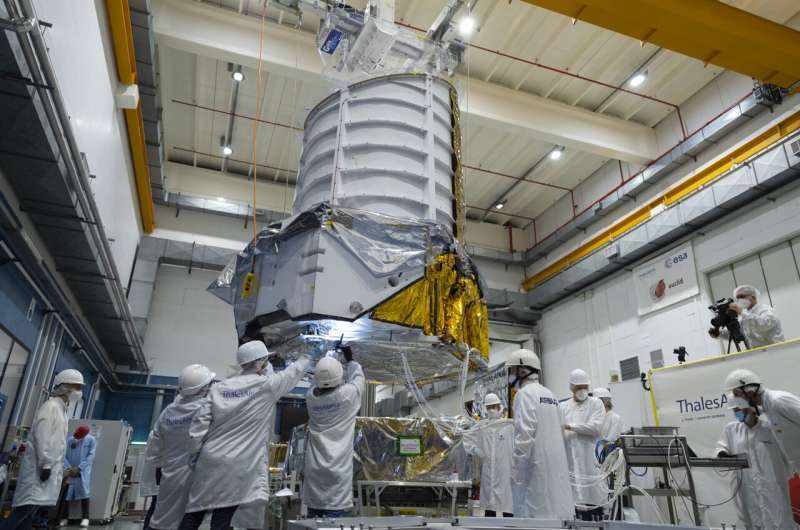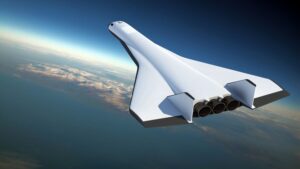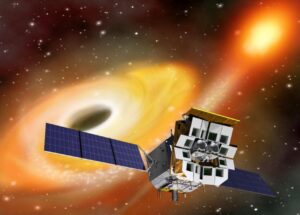Hubble uses gravity lense to spot most distant star ever seen
Thursday, 31 March 2022 03:06 NASA's Hubble Space Telescope has established an extraordinary new benchmark: detecting the light of a star that existed within the first billion years after the universe's birth in the big bang - the farthest individual star ever seen to date.
The find is a huge leap further back in time from the previous single-star record holder; detected by Hubble in 2018. That star existed when the un
NASA's Hubble Space Telescope has established an extraordinary new benchmark: detecting the light of a star that existed within the first billion years after the universe's birth in the big bang - the farthest individual star ever seen to date.
The find is a huge leap further back in time from the previous single-star record holder; detected by Hubble in 2018. That star existed when the un How scientists reviewed the process and development of space intelligent robot technology?
Thursday, 31 March 2022 03:06 It is an inevitable choice for the development of space automation technology to use space intelligent robots to realize space exploration and space resource utilization. China started with the successful launch of the Tianhe Core Module in 2021, and intends to build a large-scale, long-term manned national space laboratory during 2021-2022, and gradually develops into the China's Space Station
It is an inevitable choice for the development of space automation technology to use space intelligent robots to realize space exploration and space resource utilization. China started with the successful launch of the Tianhe Core Module in 2021, and intends to build a large-scale, long-term manned national space laboratory during 2021-2022, and gradually develops into the China's Space Station Terran Orbital begins trading on the New York Stock Exchange
Thursday, 31 March 2022 03:06 Terran Orbital Corporation (NYSE: LLAP), a leading small satellite manufacturer primarily serving the United States aerospace and defense industry, announced that its common stock and warrants will begin trading on the New York Stock Exchange, March 28, 2022, under the ticker symbols "LLAP" and "LLAP WS", respectively.
Terran Orbital has made significant progress over recent months as it p
Terran Orbital Corporation (NYSE: LLAP), a leading small satellite manufacturer primarily serving the United States aerospace and defense industry, announced that its common stock and warrants will begin trading on the New York Stock Exchange, March 28, 2022, under the ticker symbols "LLAP" and "LLAP WS", respectively.
Terran Orbital has made significant progress over recent months as it p SES expands O3b mPOWER Partner Ecosystem with Comtech for antenna systems
Thursday, 31 March 2022 03:06 SES has announced that Comtech Telecommunications Corp (NASDQ: CMTL) is supplying antenna systems for its second-generation medium earth orbit (MEO) O3b mPOWER gateways. The antenna hardware comes in a range of sizes - from the 5.5 metre gateway intended for telemetry, tracking and control (TT&C) to smaller antennas for enterprise and government use. The antennas can also be deployed as customer
SES has announced that Comtech Telecommunications Corp (NASDQ: CMTL) is supplying antenna systems for its second-generation medium earth orbit (MEO) O3b mPOWER gateways. The antenna hardware comes in a range of sizes - from the 5.5 metre gateway intended for telemetry, tracking and control (TT&C) to smaller antennas for enterprise and government use. The antennas can also be deployed as customer Extreme precision needed to attach two main parts of Euclid spacecraft together
Wednesday, 30 March 2022 16:20
On 24 March, over a dozen engineers gathered at Euclid industrial prime contractor, Thales Alenia Space in Turin, to carefully attach the two main parts of the Euclid spacecraft together.
A record broken: Hubble finds the most distant star ever seen
Wednesday, 30 March 2022 14:00 Image:
A record broken: Hubble finds the most distant star ever seen
Image:
A record broken: Hubble finds the most distant star ever seen Journey to Destination Earth begins
Wednesday, 30 March 2022 12:40
Today, the European Commission, ESA, the European Centre for Medium-Range Weather Forecasts (ECMWF) and the European Organisation for the Exploitation of Meteorological Satellites (Eumetsat) celebrated the official launch of the Destination Earth initiative: an ambitious project that involves creating a digital replica of Earth to help us move towards a sustainable future.
Jeff Matthews joins Radian Aerospace as director of strategy
Wednesday, 30 March 2022 12:00
Radian Aerospace, a startup developing a reusable spaceplane, announced March 30 that Jeff Matthews, a founding member of Deloitte Consulting’s space sector practice, would become the company’s director of strategy.
The post Jeff Matthews joins Radian Aerospace as director of strategy appeared first on SpaceNews.
Soyuz returns astronaut and cosmonauts from space station
Wednesday, 30 March 2022 11:11
A Soyuz spacecraft carrying an American astronaut and two Russian cosmonauts landed in Kazakhstan March 30, an ordinary end of a mission in extraordinary times.
The post Soyuz returns astronaut and cosmonauts from space station appeared first on SpaceNews.
Virgin Orbit looks beyond satellite launch for growth opportunities
Wednesday, 30 March 2022 10:29
Small launch vehicle company Virgin Orbit says it sees opportunities not just in satellite launch but also in hypersonics as it looks to increase its revenue.
The post Virgin Orbit looks beyond satellite launch for growth opportunities appeared first on SpaceNews.
China to launch Einstein Probe in 2023 to observe violent cosmic events
Wednesday, 30 March 2022 09:55
A Chinese wide-field x-ray space observatory has passed a major review and is expected to launch next year to detect flashes from cataclysmic cosmic events.
The post China to launch Einstein Probe in 2023 to observe violent cosmic events appeared first on SpaceNews.
Russian, US ISS record-holders return to earth
Wednesday, 30 March 2022 09:15 A record-breaking US astronaut and two Russian cosmonauts were headed for Earth Wednesday in the first space landing since Russia's invasion of Ukraine sent tensions between Moscow and the West to Cold War levels.
NASA's Mark Vande Hei is set to touch down in Kazakhstan's steppe at 1128 GMT, after setting a new record for the single longest spaceflight by a NASA astronaut by clocking 355 day
A record-breaking US astronaut and two Russian cosmonauts were headed for Earth Wednesday in the first space landing since Russia's invasion of Ukraine sent tensions between Moscow and the West to Cold War levels.
NASA's Mark Vande Hei is set to touch down in Kazakhstan's steppe at 1128 GMT, after setting a new record for the single longest spaceflight by a NASA astronaut by clocking 355 day Shenzhou XIII astronauts prep for return
Wednesday, 30 March 2022 09:15 Three astronauts stationed in China's Tiangong space station are preparing for their return trip in the middle of April, packing up personal items, experimental products and other materials, putting equipment into place and exercising to prepare their bodies for Earth's gravity.
The astronauts, Zhai Zhigang, Wang Yaping and Ye Guangfu, have to tidy up a large number of materials, including
Three astronauts stationed in China's Tiangong space station are preparing for their return trip in the middle of April, packing up personal items, experimental products and other materials, putting equipment into place and exercising to prepare their bodies for Earth's gravity.
The astronauts, Zhai Zhigang, Wang Yaping and Ye Guangfu, have to tidy up a large number of materials, including Viasat, Inmarsat to boost UK space industry investments
Wednesday, 30 March 2022 09:15 Viasat and Inmarsat, the US and UK satellite communications groups, have agreed on a package of legally-binding economic undertakings with the UK Government's Department for Business, Energy and Industrial Strategy (BEIS) as part of the proposed combination of the two companies. BEIS welcomed the constructive discussions that have taken place with both companies on their future plans. The transa
Viasat and Inmarsat, the US and UK satellite communications groups, have agreed on a package of legally-binding economic undertakings with the UK Government's Department for Business, Energy and Industrial Strategy (BEIS) as part of the proposed combination of the two companies. BEIS welcomed the constructive discussions that have taken place with both companies on their future plans. The transa MDA and US Army test integration of THAAD and Patriot missile defense
Wednesday, 30 March 2022 09:15 The Missile Defense Agency, in partnership with the U.S. Army Program Executive Office Missiles and Space, U.S. Army Space and Missile Defense Command, and Ballistic Missile Defense System Operational Test Agency, successfully conducted a flight test of the Terminal High Altitude Area Defense (THAAD) Weapon System. The test, designated Flight Test THAAD Weapon System (FTT)-21, was conducted at t
The Missile Defense Agency, in partnership with the U.S. Army Program Executive Office Missiles and Space, U.S. Army Space and Missile Defense Command, and Ballistic Missile Defense System Operational Test Agency, successfully conducted a flight test of the Terminal High Altitude Area Defense (THAAD) Weapon System. The test, designated Flight Test THAAD Weapon System (FTT)-21, was conducted at t 